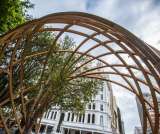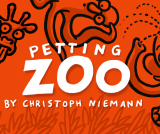
René Redzepi, chef at Noma restaurant in Copenhagen, presented at Design Indaba 2012 on his design process, Noma’s handcrafted dining room and eating better food by sharing knowledge.
René Redzepi walked on stage wearing startlingly white sneakers and projecting a neat, pale and boyish figure. Denmark’s temperatures may have cryogenic effects but his confident edge hints at youth. A dead duck followed, tied with rope to a metal frame, as if involved in a game of hangman.
René Redzepi, chef at Noma restaurant (top of the pile on Restaurant magazine’s World's 50 Best Restaurants list) and known for Nordic cuisine closely tied to nature and foraging, is a rock star of a new age.
He is irreverent, polite – even when swearing – and intent on teasing out what is truly meaningful.
Two slides in, he established his design reality with brutal honesty. An architect might create something that lasts forever, but a chef has the unique conundrum of creating "something that turns into sh*t in 24 hours". His hope is that, by creating dishes with a strong narrative, they transform into a lasting memory.
This is where the duck comes in. Hunting a duck and cooking classic duck a l’orange, he reasons, wouldn’t answer his essential questions: "What time of the year are we in?" and "Where are we in the world?" Holding his prop horizontally and keeping his pristine trainers free of blood, he explains, "Think of a duck flying… And getting shot… As it fell, what were its dying images?"
Working with what might have flashed before the duck’s eyes, Redzepi distils one moment in time. He uses beech leaves, with citrus and ginger notes, from trees close to where it landed, to frame sliced aged duck breast like a wreath; embryonic pine cones with a woody scent also lend a sense of place; and earthy tones are represented by sweet, waxy cooked beets. To keep the focus on the plate, he also re-imagines the restaurant.
"We’ve built up an idea of what fine dining is," he says. "It’s a strange act; the waiters looking down on you, the layers of gold and silver. Usually it’s the sh*ttiest of tables just made up with fine cloth."
At Noma, wooden tables are left bare to showcase the integrity of Danish design and young chefs are encouraged to enter the dining room and serve what they have made, completing the circle of picking something, turning it into food and offering it with both hands. His message to guests is, "We are here to make you happy, to give you the best deliciousness we can."
For those who might never make it to Noma, Redzepi wishes "better deliciousness". And in the name of improving what the world eats, he began building a gastronomy knowledge bank at www.nordicfoodlab. org. For chefs he launched the MAD Symposium in 2011 as an education in food culture, his concern being, "We learn to whip Béarnaise but not about wild forests or seasons."
Early on in his discussion, Redzepi drew on an observation by Ferran Adrià who presented at Design Indaba 2010: A chef tries to create a language. For Redzepi, ingredients are the letters and his goal is a bigger vocabulary.
By Nikki Werner











